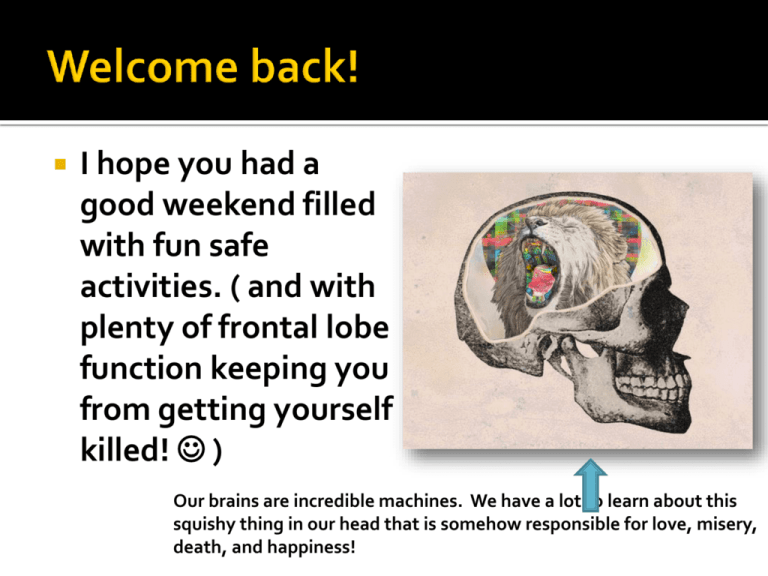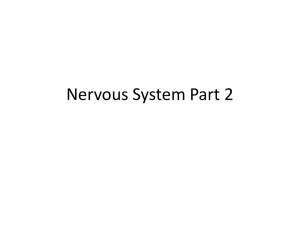File
advertisement

I hope you had a good weekend filled with fun safe activities. ( and with plenty of frontal lobe function keeping you from getting yourself killed! ) Our brains are incredible machines. We have a lot to learn about this squishy thing in our head that is somehow responsible for love, misery, death, and happiness! Class Agenda: Class Points + Doctor’s Tournament: Results of Last Semester and Restarting for this semester! Nervous System: Microanatomy ▪ How do neurons communicate? ▪ How do neurons communicate with muscles? ▪ Why do we care about any of this? Finish any presentations that we haven’t finished yet Neuro Quiz #1 will be back soon, grading now! Remember, the Doctor’s tournament is to keep everyone focused on getting the best educational experience possible. All of this, we do to help you become productive, critically thinking citizens. If you ever have questions about why we learn stuff, please talk to me after class or after school, I’d be happy to help. It took me a bit to compile all the test scores and Doctor’s Tournament Class Points Results, but here they are! (scores from the final two exams were factored in as well as behavior/attendance during the final weeks) 117 In 5th place….Period 3: In 4th place….Period 5: 120 Prize: 3% point ex.cr on last quiz! Tied for 3rd/2nd place….Period 6: 126 Prize: 5% point ex. cr on last quiz! Tied for 3rd/2nd place….Period 7: Prize: 5% point ex. cr on last quiz! And the winner is… Prize: 2 % ex.cr on last quiz! 126 Period 1: 130 Prize: 7% point ex. cr on quiz! (snacks this Friday! ) All the classes are competing for a pizza party on Mr. Ward at the end of the year after finals. Period 1 is in the lead currently, but nobody is very far behind. Who will it be?!! It’s time to learn about how neurons actually work. And it explains a whole lot of our lives. Remember: Macroscopic Microscopic: Catalyst: Step 1: Watch the following video and attempt to figure out what the 3d animation is showing. Step 2: Identify any structures/pieces of our body that you recognize from the last couple weeks. Step 3: Write 3-5 sentences describing what you see in the animation and how you think this relates to neuron communication. Axon Terminal Synapse 1. 3. 1. Axon Terminal (PRE-Synaptic) 2. Dendrite or Neuron Cell Body (POST-Synaptic) 3. Synapse/Synaptic Cleft 4. Vesicles (bubbles carrying neurotransmitters) 5. Neurotransmitters 6. Receptors (docking points for N.T. on postsynapse) …but what does he have to do with neurons?! What if a neuron wants to talk to a muscle or some other type of cell? What then?! You have a very similar type of junction, but instead of a neuron dendrite or cell body in the post-synapse, you have a muscle cell! The Action Potential: The action potential is another name for an electrical impulse, or a signal sent along a neuron. If you move your finger, action potentials from your pre-motor cortex in your brain travel all the way down to your finger and trigger the NMJ (neuromuscular junction) to shock your muscles so they contract. 1. 2. Each individual neuron must initiate an action potential Adjacent neurons must receive electrical impulse. 1. The plasma membrane of a resting neuron is polarized. (Inside of the cell is more negative than outside). Na+ ions are located on the outside while K+ are located on the inside. THIS IS PART OF AN AXON 2. DepolarizationSodium ions (Na+) rush into the cell and create an action potential (nerve impulse) *When a neuron is stimulated it causes the cell to become depolarized 3. An action potential is created- travels the length of the neuron. All or none principle- nerve impulse is either propagated over entire axon or not at all. ACTION POTENTIAL 4. Repolarization: neuron goes back to original state. BACK TO NORMAL!







